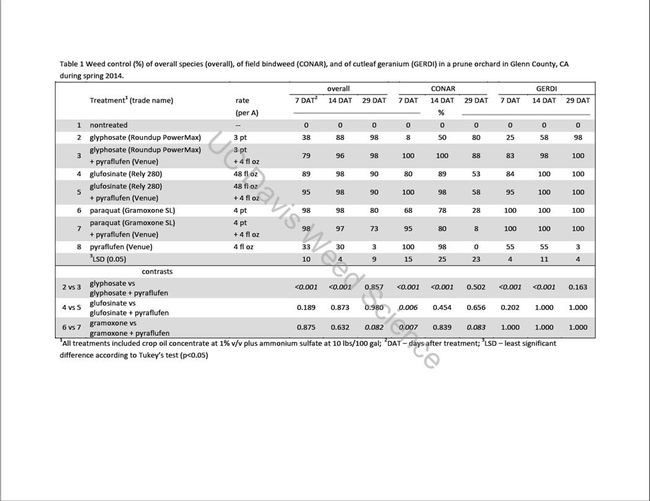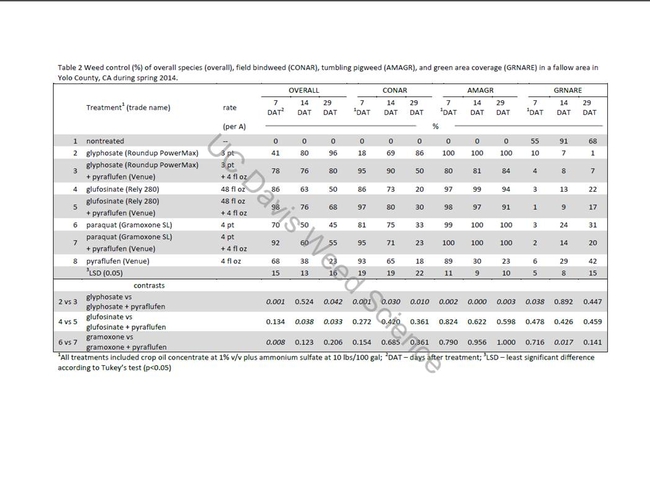Sharing the results of two recent field trials conducted to evaluate several POST herbicides with and without the addition of pyraflufen (Venue). Please note that glufosinate is not a registered treatment for prunes - this site was not harvested. The other treatment combinations are registered in most California orchard crops.
Edit 9/24/14: An oversight was pointed out to me on this post from yesterday - I didn't put these results in the context of expected performance.
According to the Venue label, "Control" can be expected for: common purslane, field bindweed, morningglory, nightshades, panicle willowherb, Russain thistle, kochia, stinging nettle, malva (small), henbit (small), and fillaree (small). The label also claims "suppression" of: marestail (small), fleabane (small), malva (large), filaree (large), and henbit (large).
That pyraflufen provided relatively little value for control of pigweeds and prostrate knotweed is not very surprising since those species are not on the label. As always, field scouting and understanding the weed spectrum present as well as the strengths and weakness of any herbicide program will usually lead to better weed management outcomes.
Brad
Effects of adding pyraflufen in tank mixes with different POST herbicides in tree nut crops of California
Marcelo L. Moretti, Seth Watkins, and Brad Hanson
University of California – Davis, CA
Pyraflufen is a contact herbicide that inhibits the activity of the enzyme protoporphyrinogen oxidase (WSSA mechanism of action –Group 14). This herbicide has activity on several broadleaf weed species when weeds are 4 inches tall or less, or pyraflufen can be mixed with other POST herbicides to increase efficacy and broaden the spectrum of weeds controlled. The objective of this study was to evaluate weed control performance of pyraflufen alone or combined in tank-mixture with other POST herbicides.
Methods:
An experiment with seven treatments plus an untreated control was conducted twice during spring 2014. The first experiment was conducted in a mature prune orchard with a silt-loam soil and furrow irrigation in Glenn County, CA. At this location, the main weed species were cutleaf geranium (GERDI), and field bindweed (CONAR). The second experiment was conducted in a fallowed, non-irrigated field with a silt-clay soil located at UC Davis. The main weed species at the Davis site were tumbling pigweed (AMAGR), which was 4 inches tall, and prostrate knotweed (POLAV), which was 5 inches in diameter at application.
The experimental design was a randomized complete block with four replicates per treatment and individual plots were 10 by 15 ft. A CO2-pressurized backpack sprayer with 4 Turbo-Teejet nozzles was used to apply treatments at 20 GPA. The Glenn and Davis experiments were initiated March 12 and May 13, 2014, respectively. Evaluations were made 7, 14, 29 days after treatment (DAT) in the first experiment, and 7, 14, 21, and 28 DAT in the second experiment. Weed control was visually estimated using a scale of 0 (no weed control) to 100% (complete weed control). In the Davis experiment, green area coverage (GRNARE) was also evaluated using digital image analysis. The method consists of taking pictures perpendicular to the soil surface at a constant height (1.9 m) and determining the proportion of green color in the image using ImageJ software.
Data were analyzed in JMP 11 (SAS Institute) using analysis of variance (ANOVA), and means were separated using Tukey's test (p 0.05). Orthogonal contrasts were used to directly compare treatments with and without pyraflufen. Data from the two sites were analyzed separately because of differences in weed species present.
Results:
In the first experiment, weed control was greater than 80% up to 14 DAT in all treatments with exception of pyraflufen applied alone (table 1). Pyraflufen provided excellent control of CONAR (>98%) and suppression of GERDI (55%) up to 14 DAT, but plants recovered later reducing weed control at the last evaluation. Overall weed control with pyraflufen applied alone was poor at 7 DAT (33%). The addition of pyraflufen to glyphosate significantly improved weed control up to 14 DAT when compared to glyphosate treatment (trt 2 vs trt 3). In contrast, the addition of pyraflufen did not improve weed control when mixed with glufosinate or paraquat as compared to those products applied alone at this site.
In the second experiment, pyraflufen provided excellent control of CONAR and AMAGR at 7 DAT, but control declined in the following evaluations (table 2). Tank-mixes of pyraflufen with glyphosate improved control of CONAR only at 7 DAT when compared to glyphosate alone. Reduced efficacy was observed in overall weed control, CONAR, AMAGR control, and GRNARE when pyraflufen was mixed with glyphosate as compared to glyphosate alone. Pyraflufen did not improve weed control when mixed with glufosinate or paraquat in this trial.
Pyraflufen applied alone provided quick burndown of CONAR at the Glenn site and CONAR and AMAGR at the Davis site; however, significant regrowth was observed by 14 DAT. Similarly, when combined with other POST herbicides, pyraflufen tankmixes had faster activity than the tankmix partners applied alone. This result was most evident at the Davis site which was treated in May under higher temperature and light conditions which contributes to faster activity of POST-applied Group 14 herbicides. The more rapid burndown observed with pyraflufen combinations usually did not result in better weed control by 14 or 28 DAT compared to the other POST herbicides applied alone.
It should be noted, however, that many of the dominant weeds in these test fields were relatively well controlled by the tankmix partner or are not strengths of pyraflufen according the label. Under more challenging conditions or in fields with different weed species, pyraflufen may improve efficacy and expand the spectrum of weed control with glyphosate.
http://www.scribd.com/doc/240740892/2014-Pyraflufen-Trial-Photos-Temp-WM" style="text-decoration: underline;" >2014 Pyraflufen Trial Photos Temp _ WM
Attached Files: